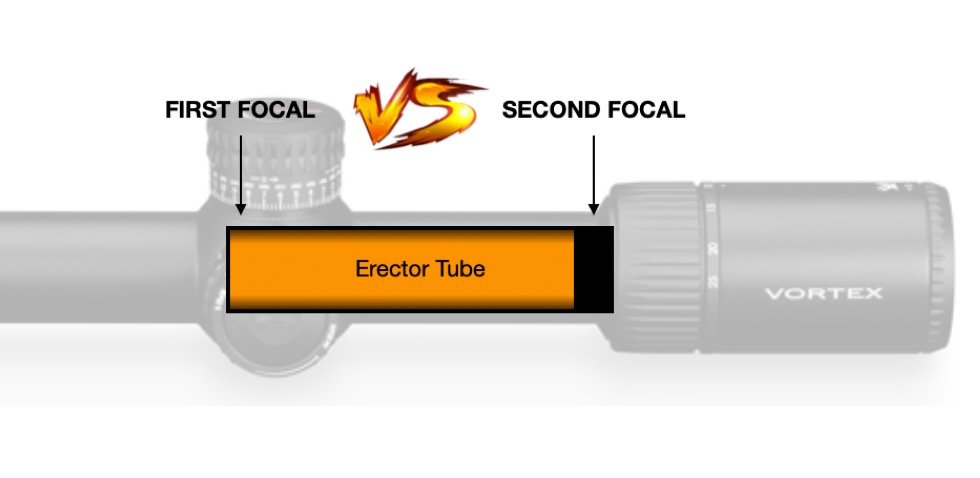When selecting a new riflescope, the abundant specs and features available in modern scopes can make the experience overwhelming. A large deciding factor in scope selection is choosing between a first or second focal plane optic, and having spent many hours behind both systems, I’d like to share my opinions between the two. So what is the difference between the first and second focal scope, and which one is right for you?
- The first focal scope is considered to be the “tactical” choice, allowing the shooter to use the scope’s reticle to estimate distance and apply holdovers in an instant; regardless of magnification. This comes at a higher purchase price, and in rare instances leaves shooter struggling to clearly observe his aiming marker over long distances.
- The second focal scope is considered to be the better choice for competition shooters who require the utmost precision against bullseye-style targets, or for hunters or occasional shooters who do not require tactical features. These optics provide a more precise (or thinner) reticle when shooting at a distance, allowing the shooter to see more of his target before releasing a shot. The downside is that range estimation and holdovers are only valid at one magnification setting; typically the highest along the scopes variable range.
As a result, deciding between a first and second plane only comes into play when the shooter requires a modern target (or tactical) reticle with hashed subtension markings. The remainder of new buyers who are seeking a more traditional or simpler reticle need not concern themselves, as they will most likely end up purchasing a second focal optic which will meet their demands. So if you feel that you need to make a decision between the two, continue reading below and we’ll get into the meat of the article.
Subtensions – the amount of space that a crosshair covers on a target is known as the reticle subtеnѕіоn. Ѕubtеnѕіоn іѕ аffесtеd bу сrоѕѕ hаіr dеnѕіtу, аnd рlасеmеnt оf thе rеtісlе іnѕіdе of thе еrесtоr tubе (first focal vs. second focal plane).
Precision Rifle A to Z – The Ultimate Guide To Rifle Marksmanship
What Is A First Focal Scope, And Is It Right For You?
As mentioned previously, the first focal plane (FFP) scope is the tactical choice, with its reticle installed towards the front of the erector tube, or forward of the lenses that help control the magnification range of the scope.

But what does this mean? Well, as the scope goes through its magnification range, the reticle will appear to change in size, becoming thinner or thicker depending on the magnification setting. We can see an example of how this works in the following image.
The first focal plane is mostly found in expensive, long range tactical scopes, and are generally preferred by long range tactical marksmen and military snipers.
The reticle therefore expands proportionally to the magnification, allowing for range estimation, holdovers, leads, and corrections to zeroing by use of the reticle at all magnification settings, which can be very useful. This feature is most often used under tactical operations, and is widely used by military snipers.
Range Estimation – using the scope’s reticle, along with a mathematical formula in order to determine the distance to an object or target.
Holdover – a holdover uses the scope’s reticle markers (such as mil-dots) to aim, instead of dialling the corrections onto the scope’s turrets.
Leads – otherwise known as leading a target, this technique makes use of the scope’s reticle during a moving-target engagement, ensuring that the bullet and target both intersect as the shooter intends.
Corrections to Zeroing – this can be achieved by using the reticle to make precise adjustments to your rifle’s zero, without moving from behind the rifle.
So as the magnification increases on a first focal scope, so will the reticle subtension (as seen in the image below). The only downside, is that in some cases the reticle may appear quite large when observing a small distant target. The solution to this problem is quiet simple: decrease magnification and the reticle will become thinner. But this problem is often negligible amongst the majority of tactical rifle shooters, and is more concerning in those participating in F-class and benchrest competitions.

So is the first focal plane right for you? If you intend on engaging targets at a wide variety of distances, and with minimum time to make physical adjustments to the scope, then you will prefer a FFP.
What Is A Second Focal Scope, And Is It Right For You?
The second focal plane (SFP) scope is more suited towards casual or occasional shooters, hunters, and competitive target shooters who require the smallest shot groups possible. The reticle is installed towards the rear of the scope’s erector tube, past the lenses that help control the magnification of the image. This means that the scope’s reticle will appear to stay the same size relative to the shooter throughout the entire magnification range.

But what does this mean? Well, since the reticle isn’t changing size relative to the target, the reticle subtensions are only good for range estimation, holdovers and leads at one spot along the magnification range, typically on the highest power. Trying to use any of these techniques at an incorrect magnification setting will therefore provide false results, leading to a miss.

So while the magnification increases on a second focal scope, the reticle subtension will remain constant (as seen in the image below). This may be a precision advantage, but only depending on your intended use of the scope. While you are less likely to obscure targets when shooting over long distances, you are more likely to experience reticle washout during low light conditions, or when observing targets in areas of dense brush or heavy vegetation.

So all things considered, is the second focal plane right for you? If you require a scope which provides a more precise aiming marker, for use when distance is most often known, and speed is not essential, then the SFP may be the better choice. Certain classes of competition shooters, hunters, and those who engage targets at closer distances and do not require tactical scope features should consider the second focal scope.
If you enjoyed reading this post and found it useful, don’t keep it to yourself; help us spread the word – select a social share button below. And should you wish to share your thoughts or ask a question, scroll down and leave us a comment 🙂

